Select a site alphabetically from the choices shown in the box below. Alternatively, browse sculptural examples using the Forward/Back buttons.
Chapters for this volume, along with copies of original in-text images, are available here.
Object type: Fragment of grave-cover
Measurements: L. 44 cm (17.3 in); W. 38 cm (15 in); D. 15 cm (5.9 in)
Stone type: Greyish yellow (10YR 8/4) oolite grainstone, with ooliths of 0.4mm diameter and some 1mm pellets. Ancaster Freestone, as Colsterworth 2
Plate numbers in printed volume: Fig. 9; Ill. 89
Corpus volume reference: Vol 5 p. 132
(There may be more views or larger images available for this item. Click on the thumbnail image to view.)
Part of a larger monument that has been cut up for secondary use as building stone; a well-formed chamfer on one corner suggests that it may have been recut for a plinth. The only surviving visible decoration is part of a cable-moulded border along one long edge.
The layout of these rather unusual components on this fragment is exactly the same as that on the mid-Kesteven group cover at Coleby Hall (Ill. 91), whose size this fragment matches almost exactly, and this correspondence confirms that this small fragment represents a grave-cover from the mid-Kesteven group (see Chapter V and Fig. 9). The only difference between the two monuments is that the decoration on Colsterworth 3 is given greater emphasis by the addition of an incised medial line, to both the interlace and the cross, which is omitted at Coleby Hall (though found elsewhere in the group on Lincoln St Mark 2, Ill. 238). The running loop across the transverse panel on the lids of these two monuments singles them out as a distinctive variant within the mid-Kesteven group, but it is not possible to say if they should be placed earlier or later in date than the other examples. The cover represented by the Colsterworth fragment, however, should be dated along with the rest of the group to the period between the mid tenth and the early eleventh century.



